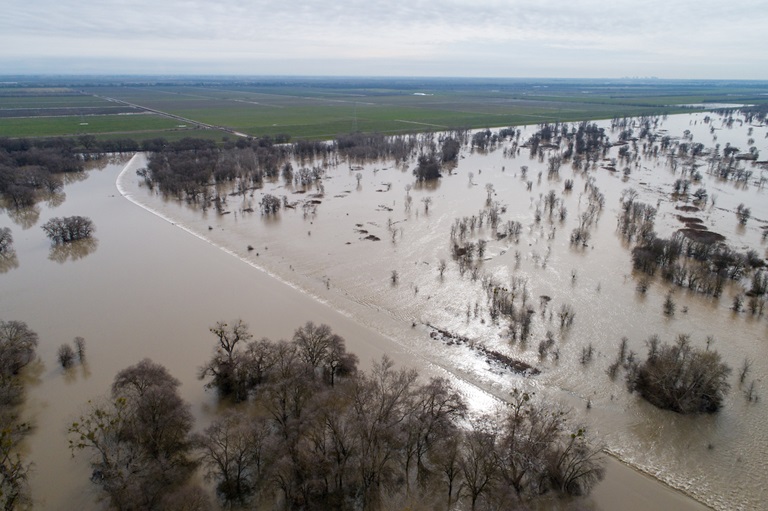Fremont Weir Upgrade Successfully Balances Need for Infrastructure and Ecosystem Preservation
A drone view of floodwaters from the Sacramento River overtopping the Fremont Weir in Yolo County. DWR/2019
The Fremont Weir Adult Fish Passage Modification Project, which began modified operations in January of 2019, successfully allowed thousands of migrating fish to pass between the Sacramento River and Yolo Bypass in its first year of operations.
The Project, located in the Yolo Bypass, modernizes the structure of the century old Fremont Weir by widening and deepening the channel that fish swim through. This upgrade makes it easier for fish to pass to upstream habitats, reduces the likelihood of them getting stranded, and is accessible to multiple fish species.
“The old structure was built with just salmon in mind,” said Josh Martinez, section chief of habitat restoration for the Department of Water Resources (DWR). “This new structure is 15-feet-wide and 10-feet-deep, replacing the obsolete four-foot wide fish ladder. Considering the weir is roughly two-miles long, a wider and deeper channel makes the passage facility easier for many fish species to find and use, not just salmon.”
By using a sound wave camera called an Aris, DWR staff was able to document 10-days’ worth of underwater readings at the new fish passage. During this time camera images documented thousands of adult fish successfully passing through the project, including more than 70 sturgeon and countless salmon. Both are species that have become so rare, that they are protected by the State and federal Endangered Species Act.
“This project was desperately needed,” Martinez said. “In the last hundred years of human interaction we’ve drastically transformed the landscape of California. We’ve replaced large inland sea floodplains with levees and dams, and 95-percent of the historic fish migration habitat is no longer accessible due to infrastructure. This project is important to reversing that trend.”
The Yolo Bypass is a critical part of the state’s flood control system, receiving flood waters from major rivers including the Sacramento, Feather, and American. When flooded, the bypass becomes the largest seasonal floodplain in the Delta and a migration corridor for dozens of native fish species, including winter- and spring-run Chinook salmon, steelhead, and green sturgeon.
“As the Sacramento River approaches a potentially dangerous level it overflows the Fremont Weir and diverts water through the Yolo Bypass,” Martinez said. “This project turns what is primarily a flood control facility into one that serves multiple benefits. It’s a first-of-its kind structure for California that aims to balance infrastructure and ecosystems.”
The project broke ground in 2018 as a collaborative effort between DWR, the U.S. Bureau of Reclamation, and in coordination with the California Department of Fish and Wildlife (CDFW). Before the project was in place, some migrating salmon and sturgeon would become stranded in the Bypass, forcing CDFW to capture the stranded fish and release them into the Sacramento River by hand. This new structure drastically reduces any stresses from human intervention.
The first year of operations did come with some learning moments for DWR. Following a series of weather events in late March of 2019, water from the Sacramento River reached overtopping levels and the Fremont Weir was used for flood protection. During this event DWR staff could not safely open the fish passage door manually, so the structure could not be used, and fish passage ability reverted to pre-project conditions.
Those conditions caused fish to become stranded as they had for decades. Once floodwaters receded, DWR staff was able to safely access the site and open the gates of the passage. A month later the passageway was reopened under a modified schedule, and thousands of fish successfully passed through. The facility has since been programmed to open automatically, further reducing the risk of stranding by negating the need for staff to physically be onsite to open the facility.
The American Society of Civil Engineers (ASCE) Sacramento section selected this project as its 2019 Outstanding Environmental Engineering Project Award Winner in June 2020.
ASCE is the oldest engineering society in the nation and represents more than 150,000 civil engineering professionals in 177 countries.
Learn more about other DWR restoration projects in the Yolo Bypass.
